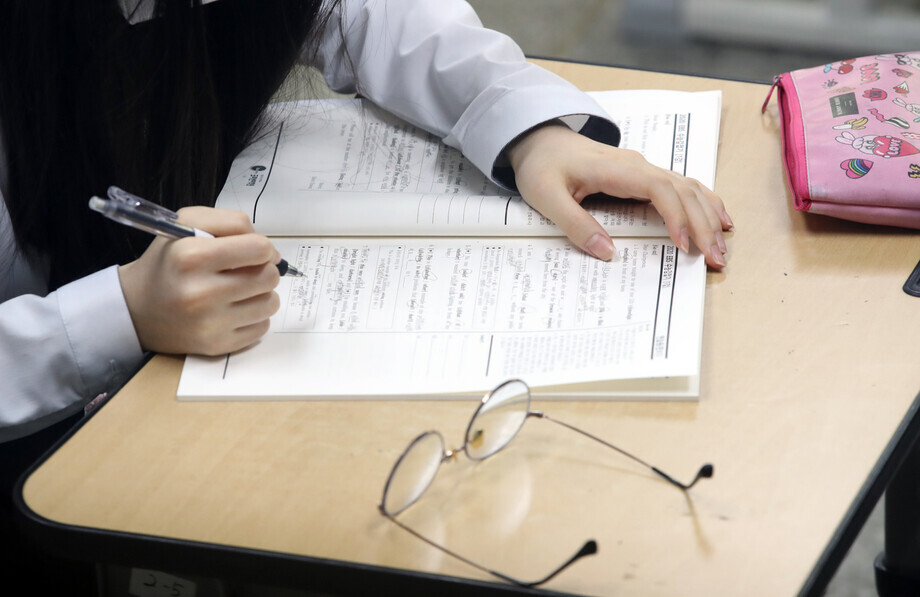hankyoreh
Links to other country sites 다른 나라 사이트 링크
More students underperform in school amid COVID-19 pandemic

A high school in the South Korean city of Gwangju is currently alternating between in-person classes and remote classes for students in the first and second years. On days when classes are held remotely, a teacher at the high school surnamed Kim spends as much time on the phone as a call center employee. She’s busy waking up students who are still asleep.
Even as the COVID-19 pandemic enters its second year, students seem to be still struggling to adjust to the new routine.
“Students who aren’t as good at self-directed learning don’t answer when you call on them online and are often playing with their cell phone even in the classroom,” Kim said.
“On the other hand, some students who were in the 40th to 60th percentiles before COVID-19 have risen to the top 4 percentile,” Kim said in a voice that expressed her helplessness and frustration for her students.
The middle ranks at high schools have thinned out since the pandemic began. But studies show this represents an overall decline in academic ability, with more students falling into the low-scoring group than climbing into the high-scoring group.
In a press conference on Monday, an educational nonprofit called World Without Worries About Private Education released the results of a study of academic disparities during the COVID-19 pandemic. The nonprofit carried out the study in partnership with the broadcaster YTN.
This study covered students in the second year of middle school and the first year of high school at all middle schools (560) and high schools (413) in a sample of 31 cities, counties, and districts in eight provinces and metropolitan cities, including Seoul, Gwangju and North Jeolla Province. The analysis in this study was based on academic achievement data in Korean language, English language, and math posted to the government’s school information service.
The study found that middle schools were undergoing academic polarization, with the mid-scoring group shrinking and the high-scoring and low-scoring groups increasing in size. There was an overall deterioration of academic performance in high schools, with the low-scoring group expanding considerably as both the mid-scoring and high-scoring groups decreased in size.
An analysis of academic achievement for first-year high school students in Korean language, English language, and math in the first semester of 2019 found the following distribution: 18.5% of students were in the high-scoring group (A), 54.8% in the mid-scoring group (B-D), and 26.7% in the low-scoring group (E).
But in the first semester of 2020, after the outbreak of COVID-19, 17.2% of students were in the high-scoring group, 50.4% in the mid-scoring group, and 32.4% in the low-scoring group. In short, the high-scoring group decreased by 1.3 points and the mid-scoring group by 4.4 points, while the low-scoring group increased by 5.7 points.
“Students in the mid-scoring group are those who can enter the high-scoring group with in-person assistance from teachers and staff, which means they have the most to gain from in-person classes. First-year high school students in the mid-scoring group have struggled the most with their basic studies both because of remote learning and also because of the increasing difficulty of curriculum at the high school level,” said Chun Gyeong-won, an official in charge of education policy for Gyeonggi Province.
“The disaster [of COVID-19] has come to every school, but that disaster has certainly not had an even impact. While the gap in public schooling has hit some areas very hard, areas with high levels of private education have actually taken this disaster as an opportunity to elevate more students into the high-scoring group,” said a spokesperson for the nonprofit.
By Lee Yu-jin, staff reporter
Please direct comments or questions to [english@hani.co.kr]

Editorial・opinion
![[Editorial] Penalties for airing allegations against Korea’s first lady endanger free press [Editorial] Penalties for airing allegations against Korea’s first lady endanger free press](https://flexible.img.hani.co.kr/flexible/normal/500/300/imgdb/original/2024/0502/1817146398095106.jpg) [Editorial] Penalties for airing allegations against Korea’s first lady endanger free press
[Editorial] Penalties for airing allegations against Korea’s first lady endanger free press![[Editorial] Yoon must halt procurement of SM-3 interceptor missiles [Editorial] Yoon must halt procurement of SM-3 interceptor missiles](https://flexible.img.hani.co.kr/flexible/normal/500/300/imgdb/child/2024/0501/17145495551605_1717145495195344.jpg) [Editorial] Yoon must halt procurement of SM-3 interceptor missiles
[Editorial] Yoon must halt procurement of SM-3 interceptor missiles- [Guest essay] Maybe Korea’s rapid population decline is an opportunity, not a crisis
- [Column] Can Yoon steer diplomacy with Russia, China back on track?
- [Column] Season 2 of special prosecutor probe may be coming to Korea soon
- [Column] Park Geun-hye déjà vu in Yoon Suk-yeol
- [Editorial] New weight of N. Korea’s nuclear threats makes dialogue all the more urgent
- [Guest essay] The real reason Korea’s new right wants to dub Rhee a founding father
- [Column] ‘Choson’: Is it time we start referring to N. Korea in its own terms?
- [Editorial] Japan’s rewriting of history with Korea has gone too far
Most viewed articles
- 160% of young Koreans see no need to have kids after marriage
- 2Months and months of overdue wages are pushing migrant workers in Korea into debt
- 3[Editorial] Penalties for airing allegations against Korea’s first lady endanger free press
- 4Historic court ruling recognizes Korean state culpability for massacre in Vietnam
- 5Presidential office warns of veto in response to opposition passing special counsel probe act
- 6[Reporter’s notebook] In Min’s world, she’s the artist — and NewJeans is her art
- 7Bills for Itaewon crush inquiry, special counsel probe into Marine’s death pass National Assembly
- 8In rejecting statute of limitations defense in massacre case, Korean court faces up to Vietnam War a
- 9[Guest essay] How Korea must answer for its crimes in Vietnam
- 10Story of massacre victim’s court victory could open minds of Vietnamese to Korea, says documentarian